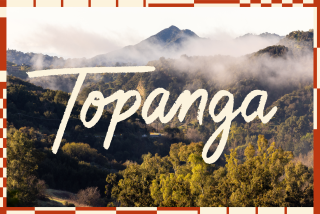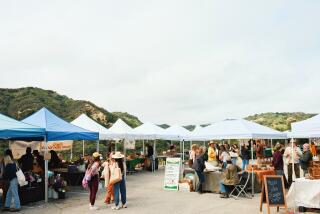Tradition and a Modern World Coexist in Tonga
- Share via
NUKU'ALOFA, Tonga — Down 80 feet, the water off Tongatapu Harbor was unclear. Siltation gave the water a blurry cast, coloring everything a dull brownish-gray. My scuba diving companion and I were waiting for dive guide Bob Holcombe to lead us forward.
I was unprepared for what followed. A thick green canopy appeared in the shape of a well-trimmed garden hedge--brilliant green, startlingly out of context. But this was not some mental fixation, it was living black coral. We could see finely twisted strands of the coral beneath a covering of tear-shaped green leaves.
The black coral tree was near the entrance to the shipping channel leading to Tongatapu Island, the most populated island in the Kingdom of Tonga.
Beyond the harbor lay Tongatapu’s lagoon, a wide expanse of clear water, shallow coral reefs and lush tropical islands. Most of it is accessible to scuba divers by speedboat from Nuku’alofa--the main town and royal capital.
British Heritage
Here are small markets, Japanese cars and Victorian-style buildings that stand like guardians of an age when the British Empire ruled the Pacific Ocean and Tonga was its protectorate.
But these days, everywhere in Nuku’alofa are signs of change. At one end of town bulldozers are carving huge port facilities for an industrial area. At the other end, Tongans gather on the reef in front of the Royal Palace to collect sea cucumbers for the king’s dinner.
Tonga is a chain where a traditional Polynesian life and the modern world coexist in a delicate balance. The chain includes 170 islands, coral lagoons, clear waters, shipwrecks and large schools of fish. It is one of the world’s lesser-known diving destinations.
Friendly Island Air
So few scuba divers come to Tonga that the fish in the remote areas of the reefs show little fear. We also saw this several days later at Tonga’s Vava’u group, a two-hour plane ride from Tongatapu via the country’s only airline, Friendly Island Airways.
Vava’u is one of the few places in the South Pacific where the outboard motor has not replaced the outrigger canoe. At the top of the island is a small town, Neiafu, overlooking a natural harbor.
Our dive guide in Vava’u was transplanted New Yorker Peter Goldstern. His dive shop is in a small workroom at the end of a series of bungalows that make up the Tongan Beach Resort hotel.
The journey across the lagoon was in Goldstern’s high-speed boat. Small, well-kept villages dot the hillsides overlooking the harbor. Fishermen in outrigger canoes paddle toward uninhabited islands. Men on horseback ride on the beach.
Goldstern took us first to a coral ledge 65 feet below the surface. There we waited, perched on the edge of a vertical dropoff as a school of groupers approached. They were heavy, fleshy fish with black leopard spots and showed more interest than fear. They hovered over the blackness of the dropoff, stared at us, turned away and then stared again.
A giant eagle ray swam over our heads as we made our way back to the boat. Beneath us a clump of large, thin, black coral discs, known popularly as lettuce coral, spread across the sand. The delicate black discs were interspersed with soft white mats of flowing anemone and orange clown fish.
Underwater Gardens
We also dived at Coral Gardens, a 300-yard stretch of bright coral that extends between two low islands. Less than 10 feet below the surface we found small solid-looking clumps of red and purple coral, side by side with larger, fragile-looking corals in green, white and pink. In the bright afternoon sunlight the effect was dazzling.
Of all of the dives in Tonga the most remarkable was the last, down a narrow rock at the edge of Vava’u Harbor. The pinnacle appears as a small narrow mound in the middle of deep ocean, so small that it took several tries before the boat’s anchor could be attached to its side. The moment we stepped over the side, a massive vertical rock wall loomed before us.
We made our way down slowly along the jagged face of a narrow sea cliff, steadying ourselves against the current.
Seventy feet below we approached the base of the wall. Our lights showed an opening barely wide enough to move through with our tanks.
Unscheduled Surprises
Goldstern squeezed through first; my friend and I followed. Twenty feet in, the tunnel widened into an undersea chamber. Inside were five large groupers, so stunned by our sudden appearance in their private world that they floated motionless as we swam past.
Gradually another opening came into view and the black of the sea cave gave way to the filtered green brightness of the open ocean.
We swam up out of the cave toward a small ledge. The sight of a six-foot moray eel at the base of the cave brought us to a sudden stop. Its heavy black skin covered a body that seemed like a single strand of muscle. The creature was looking away from us. We gave it a wide berth and started slowly up to the surface.
The effect of swimming toward the boat along the vertical pinnacle face was akin to flying. Our hands reached for small recesses in the rock to steady ourselves as we floated up across a wall as high as a five-story building.
It was an exhilarating feeling of floating through space, stopping momentarily to look down into the clear deep waters and then moving up again.
We came to the end of the dive and waited for our decompression period, hanging onto the anchor line 10 feet below the surface. As we waited, I felt the silence of the open ocean and watched fish as they moved calmly beneath us. The most unusual aspect of diving here was again the lack of fear on the part of marine animals.
-- -- --
Tonga is most easily reached via Hawaiian Airlines from Honolulu. Those wishing to dive should bring their own equipment; rental gear is limited. Dive shops are Coral Head Divers on Tongatapu, run by California expatriate Bob Holcombe, and Goldstern’s shop on Vava’u. (Although the shops offer supervision, medical facilities for treating diving accidents are not available.)
Accommodations are in hotels or at reasonably priced rooming houses on Tongatapu and Vava’u.
International Date Line Hotel, the main hotel on Tongatapu, costs $45 a day. The cost at Sela’s guest house, a home with private rooms and simple beds for guests, is $10 a day, including three meals.
On Vava’u, the Paradise is a beautiful luxury hotel. Its rooms cost $75 a day. A guest house across the street has rooms for $12. Other accommodations are on the small resort islands of Lifua.
Tonga has no fine restaurants. The best places to eat are in the guest houses, where the food is plentiful and the cooks are the proprietors.
Keep your itinerary flexible; inter-island flights sometimes follow inconsistent schedules.
For more information on travel to Tonga, contact the Government of Tonga office in Hawaii: P.O. Box 50023, Honolulu, Hawaii 96850, phone (808) 537-9525.
More to Read
Sign up for The Wild
We’ll help you find the best places to hike, bike and run, as well as the perfect silent spots for meditation and yoga.
You may occasionally receive promotional content from the Los Angeles Times.






